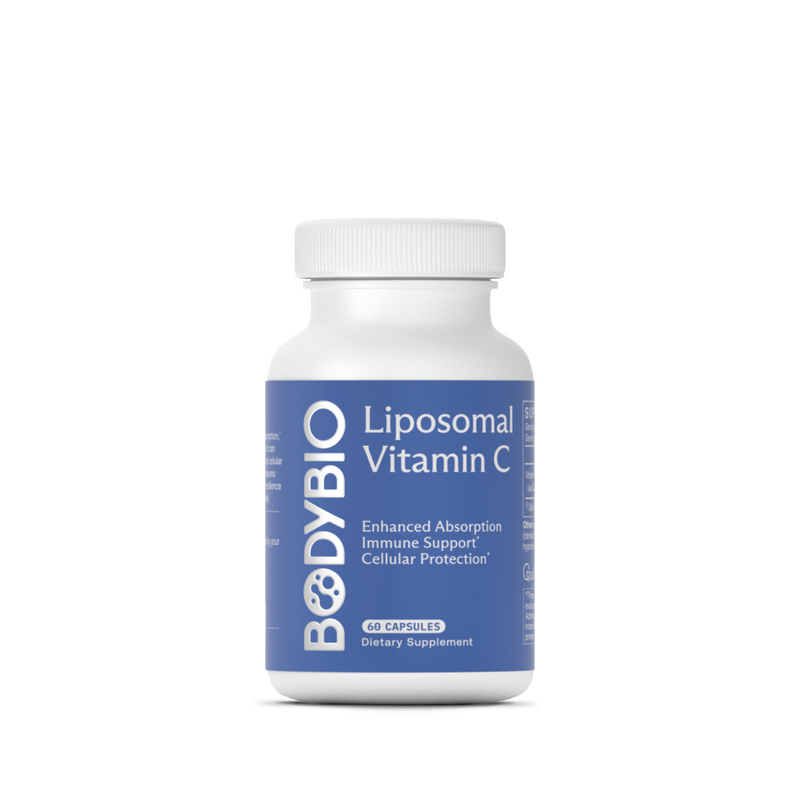Supplements for Sun Protection: How to Stay Sunburn-Free This Summer
Authors:

Dr. Thomas Wnorowski
PhD, CNCC Research Director, BodyBio & Biomedical Nutritionist
Key Takeaways:
Key Points:
- Sun exposure is a vital ingredient for our overall health. Not only is it deeply connected with mitochondria health and function, but a healthy dose of vitamin D is associated with better mood, improved sleep, lower blood pressure, and so much more.
- In order to reap the benefits of moderate sun exposure, most people will need to get their bodies used to being outside. Prioritizing sun exposure at sunrise and sunset is a good way to slowly adjust your tolerance while avoiding sunburn.
- Another way to decrease your risk of sunburn and encourage healthy skin is to “eat your sunscreen.” There are a number of vitamins for sun protection to help you tolerate the sun, like polyphenols, vitamin C, and essential fatty acids.
Slather yourself in sunscreen, they said.
You’ll be protected, they said.
A nasty sunburn is the best way to ruin a beach vacation. But you know what’s even worse? Benzene exposure. Yep, sunscreen is hiding a lot of dirty secrets — and one of them is benzene, a known carcinogen recently detected in popular sunscreen brands.
Benzene isn’t the only problem with sunscreen. We’re experiencing a global vitamin D deficiency — and many researchers agree that constant sunscreen use has a lot to do with it.
It doesn’t help that makeup brands continue to pump every skin product full of sunscreen, and anti-aging commercials convince us that sunshine is the primary reason for wrinkles. We're looking into the real underlying question: How do we cultivate a healthy relationship between the sun and our bodies?
While sunscreen is a popular choice, nature offers a plethora of foods and supplements that can provide additional protection from within without carcinogens. Let’s explore natural sunscreen alternatives and vitamins that can protect you from getting too much sun while still enjoying the many benefits of sunlight for our health.
Table of Contents:
- How Does Sun Exposure Impact Your Cells?
- Rethinking Our Relationship with Sun Exposure
- The Time and Place for Sunscreen Use
- How to Protect Your Skin From the Sun Naturally
- 6 Vitamins and Foods That Provide Sun Protection
How Does Sun Exposure Impact Your Cells?
With so much noise about sun exposure being bad for you (and overzealous recommendations to avoid it at all costs), let’s remember to go back to the basics of science.
Energy from the sun is harnessed by the body to fuel the mitochondria, the energy factories of our cells.
This may be why feelings of tiredness, brain fog, and even moodiness may slowly lift when we spend time outside. And perhaps why sleep quality increases when we prioritize morning and evening sunlight.
For thousands of years, humans have lived in harmony with the sun — even so far as to worship it in some ancient cultures. Moderate sunshine exposure isn’t something to be feared, it’s something to be enjoyed and appreciated. It’s nature’s vitamin and energy booster.
The more we learn to live well with the sunshine, the happier our cells will be.
Rethinking Our Relationship with UV Exposure
Skin cancer and sunburn are two very real health risks associated with UV rays (over-exposure, that is). But these risks don’t mean we should avoid the sunshine entirely. In fact, there are numerous benefits of healthy sun exposure, which may outweigh the risks.
Here are just a few ways you may benefit from a healthy dose of sun:
- Better mood
- Stronger bones
- Lower blood pressure
- Lower stress
- Better sleep
- Weight loss
- Protection against colds and flu
- Immune system health
- Increase vitamin D levels
- Protection against chronic illness
While excessive UV rays may contribute to dermatological health issues, we’re not so sure sunscreen is much better. The key to harnessing the benefits of the sun without risking your long-term health? Balance.
The Time and Place for Sunscreen Use
While most of us spend long hours indoors instead of outside in the sun, there are some situations where the opposite is true! Long days of yard work, beach vacations, and outdoor sports put us at risk for sunburn — which is unhealthy for our cells, and can cause premature aging.
So, how do we find balance? There are healthier sunscreen alternatives available, like mineral-based sunscreen — a product that typically harnesses zinc oxide to protect our skin from extreme exposure (and is safer than toxic chemical sunscreens).
If you need to use conventional sunscreen for protection, use it minimally, and switch to a mineral-based version when you can.
How to Protect Your Skin From the Sun Naturally
Sunscreen isn’t the only way to naturally prevent sunburn — and really should be used sparingly. Here are some other ways you can prevent sun damage in everyday life:
- Wear lightweight clothes with extra coverage for natural sun protection.
- Avoid sunburn by working your way up to moderate sun exposure.
- Eat foods that provide sun protection.
1. Wear Lightweight Clothes with Extra Coverage for Natural Sun Protection
Long sleeves and a wide-brim hat can do a lot to protect you against sunburn (while still allowing you to soak up vitamins and benefits from the sun). If you’re attending an afternoon soccer game or having a picnic with friends, this may be an effective way to cover up that doesn’t require toxic sunscreen. Remember to stay hydrated and wear lightweight clothing.
2. Avoid Sunburn by Working Your Way Up to Moderate Sun Exposure
Our bodies are brilliant, and they know how to handle moderate sun exposure, especially if you work your way up to it. Spend time getting light doses of sunshine — preferably during sunrise and sunset. Around 30 minutes a day can get your skin and body used to the sun exposure, and you can gently work your way up to more moderate sun exposure (a few hours a day).
3. Eat Foods That Provide Sun Protection
Yep, there are a variety of foods that can actually help your body protect itself from the sun — from the inside out. Some of these nutrients include polyphenols, vitamins, beta carotene, fatty acids, and antioxidants, which we’ll explore more in-depth next.
6 Vitamins and Foods That Provide Sun Protection
It isn’t a scam — you can actually use a number of foods and vitamins for sun protection. There are a variety of nutrients that can help to build up your tolerance to the sun, curbing sunburn and unwanted symptoms while allowing you to soak up all that healthy vitamin D.
1. Polyphenols
These are compounds released by plants when they need a little extra protection. For instance, if a plant becomes injured, it may release polyphenols to heal. Want to see polyphenols in action? Cut open an avocado and see how long it takes to turn brown. The browning that occurs is almost like a protective “scab” that forms when the plant is exposed to oxygen. The release of polyphenols in the browning process protects the avocado from bacteria, allowing it to last longer.
Polyphenols actually help to protect plants against UV rays — and there’s evidence they can do the same for humans. When we consume polyphenols we may notice that our skin becomes less sensitive to sun exposure. Most commonly these are found in:
- Berries
- Fruits
- Wine
- Nuts and seeds
- Coffee
- Olives
- Beans
- Dark chocolate
2. Vitamin E and C
As powerful antioxidants, vitamin E and vitamin C are both sun protection vitamins that can work wonders to protect your body against sunburn. Having adequate vitamin E may actually absorb and offset some of the sun’s UV rays, reducing free radicals and cell damage in the body. Foods that may prevent sunburn and are rich in vitamin E include:
- Almonds
- Sunflower seeds
- Pine nuts
- Salmon
- Avocado
Vitamin C, applied topically or consumed orally, has been shown to reverse sun damage to the skin while increasing and stabilizing collagen, the structural protein that makes up our skin, ligaments, and other tissues. You can increase your intake of vitamin C by including these foods in your diet:
- Citrus fruits
- Leafy green vegetables
- Cruciferous vegetables
- Bell peppers
3. Beta Carotene
Maybe some of the most promising foods that provide sun protection are those rich in beta-carotene. This includes many red, yellow, and green fruits and vegetables such as:
- Carrots
- Spinach
- Tomatoes
- Sweet potatoes
- Watermelon
Perhaps this is one reason we crave watermelon for hot summer days. These foods are not only rich in beta-carotene but also offer a range of other beneficial vitamins, minerals, and antioxidants.
In studies, molecules of beta carotene have been shown to directly absorb UV rays, diverting them away from the cell itself. It will take a few weeks of faithful carrot-eating before you really notice the promising effects of beta-carotene as a sunscreen alternative, though.
4. Selenium
We’re convinced — most people are low in selenium. Among its many benefits, selenium has been shown to help maintain cardiovascular and thyroid health, promote a strong immune system, and boost brain health. It can also help protect against UV rays by helping the body produce enzymes needed to repair cellular damage caused by the sun.
Foods rich in selenium include:
- Brazil nuts
- Whole grains
- Egg yolks
- Certain mushrooms such as shiitake and button
5. Zinc
A common ingredient in mineral-based sunscreens, zinc can be used inside and outside the body to protect against sun damage. Zinc has been studied for its powerful skin benefits before — recommended for patients with rosacea, melasma, and dandruff. Topically, a zinc-based mineral sunscreen may divert excess UV rays. When supplemented internally, zinc works as an antioxidant for cellular regeneration and DNA repair, supporting recovery from sun exposure.
Here are some of the best zinc-rich foods that provide sun protection:
- Oysters
- Pumpkin seeds
- Tofu
- Leafy greens like spinach
- Dark chocolate
6. Essential Fatty Acids
Heavy exposure to ultraviolet radiation (UVR) can occur when we are exposed to too much direct sun. In response, blood vessels dilate and increase blood flow, and direct immune cells to the site of the injury. You may notice this inflammation if you touch a red and swollen sunburn and see your skin change color under your fingers.
Fatty acids, particularly omega-3s, can help to cool down this inflammation which makes them useful vitamins for sunburn. According to this recent study, omega-3 fatty acids are being explored as an all-natural sunscreen option due to their vast photoprotective properties. If you’re looking to eat more omega-3, consider adding these to your diet:
- Fatty fish such as salmon and bluefin tuna
- Chia and hemp seeds
- Walnuts
- Algae, such as spirulina
- BodyBio Balance Oil
Shop the Best Supplement for Sun Protection and Enjoy the Sun More
If you’ve spent your whole life stressing about sun exposure, or you’re shut indoors most days, it can feel intimidating to begin working up your tolerance to mid-day sun exposure. Let us reassure you: your body knows how to adapt, and you can do this safely.
You might just need a little support from vitamins that provide sun protection.
Our Liposomal Vitamin C is not only a powerful immune system booster — but it’s a strong antioxidant, too. Applying vitamin C topically to the skin is an extremely popular method for sun damage repair. Imagine the magic that could happen if you started nourishing your cells from the inside out.
Begin Building Up Your Sun Tolerance with Liposomal Vitamin C
Saric, S., & Sivamani, R. K. (2016). Polyphenols and Sunburn. International journal of molecular sciences, 17(9), 1521. https://doi.org/10.3390/ijms17091521
Mead M. N. (2008). Benefits of sunlight: a bright spot for human health. Environmental health perspectives, 116(4), A160–A167. https://doi.org/10.1289/ehp.116-a160
Al-Niaimi, F., & Chiang, N. Y. Z. (2017). Topical Vitamin C and the Skin: Mechanisms of Action and Clinical Applications. The Journal of clinical and aesthetic dermatology, 10(7), 14–17.
Stahl, W., & Sies, H. (2012). β-Carotene and other carotenoids in protection from sunlight. The American journal of clinical nutrition, 96(5), 1179S–84S. https://doi.org/10.3945/ajcn.112.034819
Pilkington, S.M., Watson, R.E., Nicolaou, A., Rhodes, L.E (2011). Omega-3 polyunsaturated fatty acids: photoprotective macronutrients. Exp Dermatol, 20(7), 537-43. https://doi.org/10.1111/j.1600-0625.2011.01294.x
Leccia, M.T., Richard, M.J., Beani, J.C., Faure, H., Monjo, A.M., et al. (1993). Protective effect of selenium and zinc on UV-A damage in human skin fibroblasts. Photochem Photobiol, 58(4), 548-53. https://doi.org/10.1111/j.1751-1097.1993.tb04930.x
Eberlein-König, B., Placzek, M., Przybilla, B. (1998). Protective effect against sunburn of combined systemic ascorbic acid (vitamin C) and d-alpha-tocopherol (vitamin E). J Am Acad Dermatol, 38(1), 45-8. https://doi.org/10.1016/s0190-9622(98)70537-7

